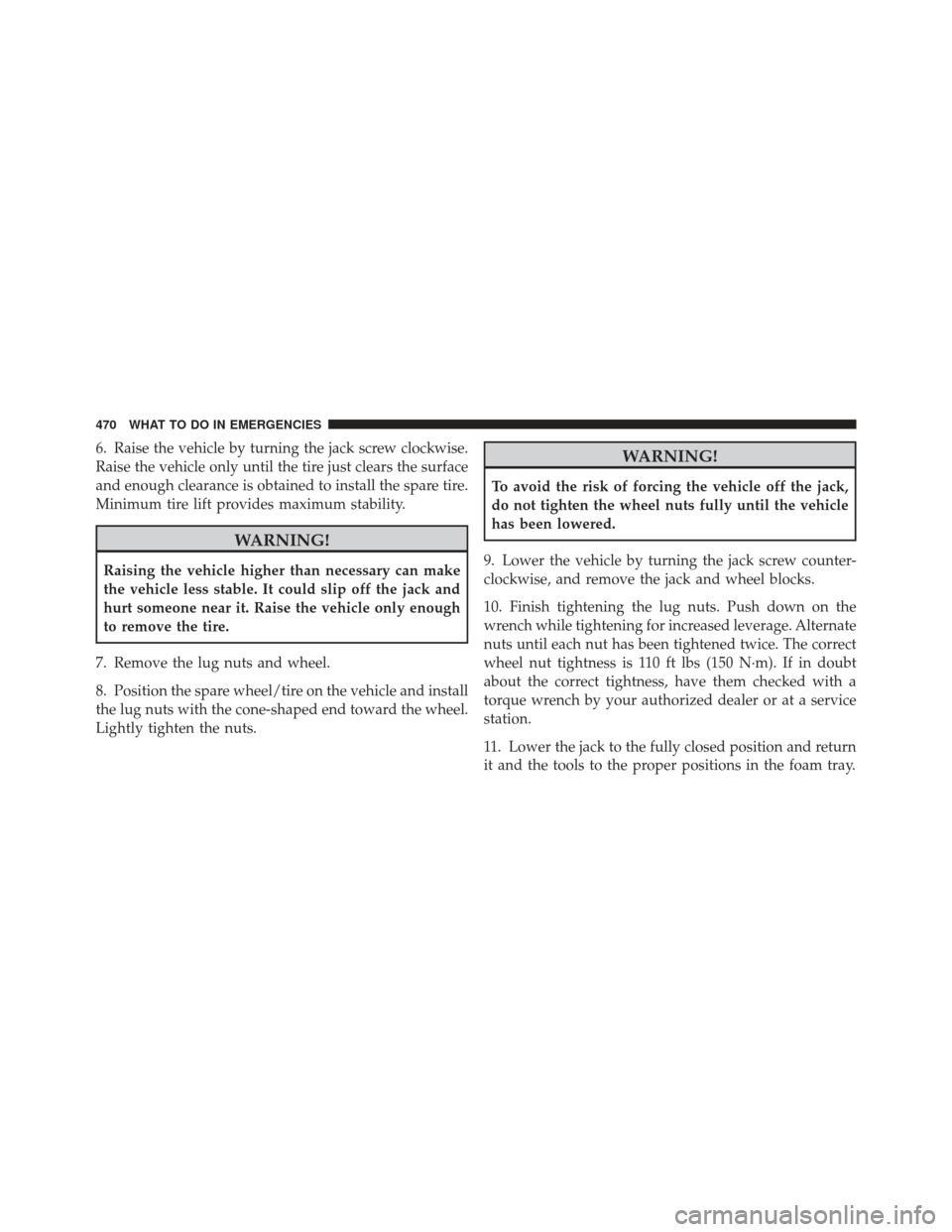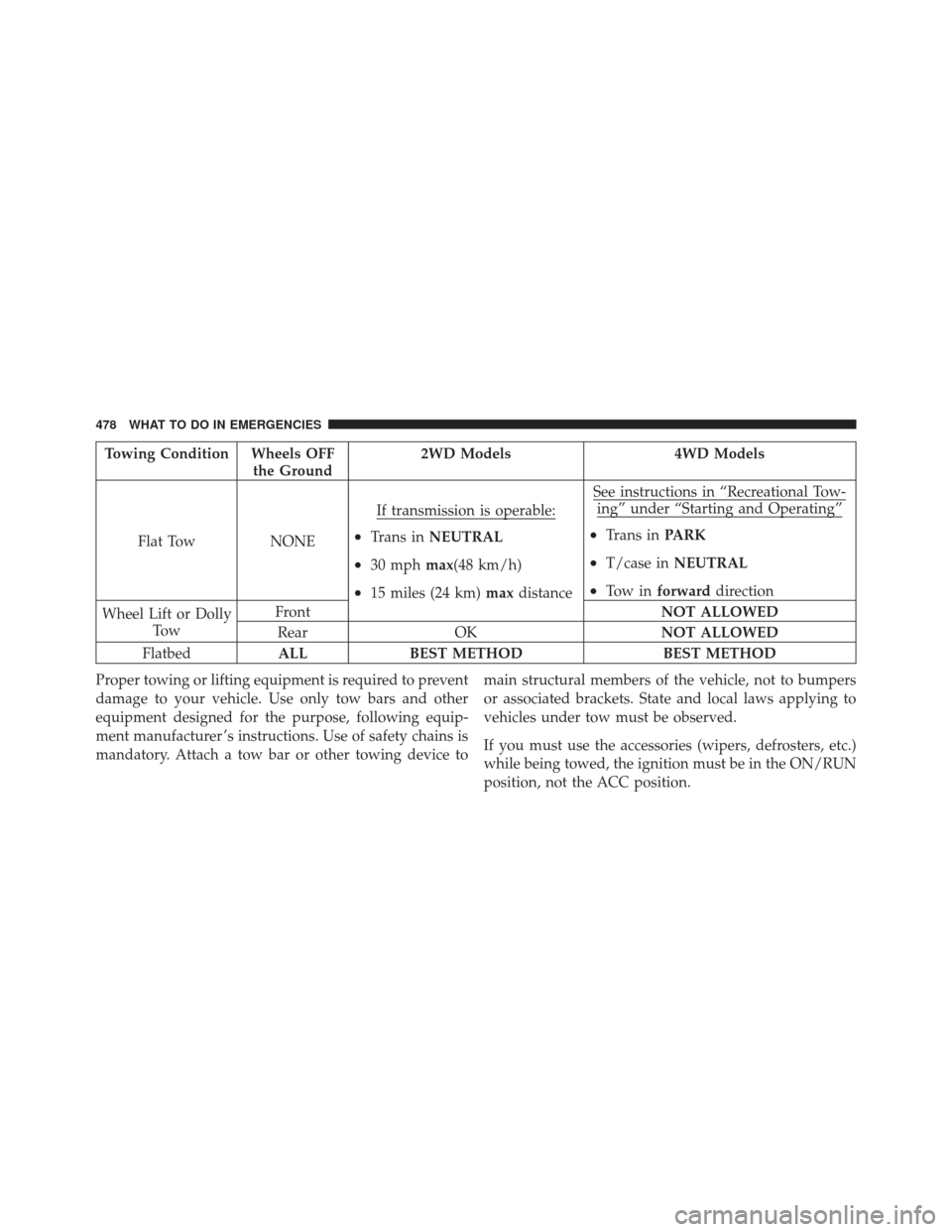Page 463 of 587
WHAT TO DO IN EMERGENCIES
CONTENTS
�Hazard Warning Flashers ................ 462
� If Your Engine Overheats ................ 462
� Jacking And Tire Changing ............... 463
▫ Jack Location ....................... 464
▫ Spare Tire Stowage ................... 464
▫ Preparations For Jacking ............... 465
▫ Jacking Instructions ................... 466 �
Jump-Starting ........................ 471
▫ Preparations For Jump-Start ............. 472
▫ Jump-Starting Procedure ............... 473
� Emergency Tow Hooks — If Equipped ...... 475
� Shift Lever Override ................... 476
� Towing A Disabled Vehicle ............... 477
▫ Towing Without The Ignition Key FOB ..... 479
▫ Two-Wheel Drive Models .............. 479
▫ Four-Wheel Drive Vehicles .............. 480
6
Page 465 of 587

•You can also turn the temperature control to maximum
heat, the mode control to floor and the blower control
to high. This allows the heater core to act as a
supplement to the radiator and aids in removing heat
from the engine cooling system.
CAUTION!
Driving with a hot cooling system could damage
your vehicle. If the temperature gauge reads HOT
(H), pull over and stop the vehicle. Idle the vehicle
with the air conditioner turned off until the pointer
drops back into the normal range. If the pointer
remains on HOT (H), and you hear continuous
chimes, turn the engine off immediately and call for
service.
WARNING!
You or others can be badly burned by hot engine
coolant (antifreeze) or steam from your radiator. If
you see or hear steam coming from under the hood,
do not open the hood until the radiator has had time
to cool. Never try to open a cooling system pressure
cap when the radiator or coolant bottle is hot.
JACKING AND TIRE CHANGING
WARNING!
•Do not attempt to change a tire on the side of the
vehicle close to moving traffic. Pull far enough off
the road to avoid the danger of being hit when
operating the jack or changing the wheel.(Continued)
6
WHAT TO DO IN EMERGENCIES 463
Page 467 of 587
Preparations For Jacking
1. Park the vehicle on a firm, level surface. Avoid ice or
slippery surfaces.
WARNING!
Do not attempt to change a tire on the side of the
vehicle closest to moving traffic, pull far enough off
the road to avoid being hit when operating the jack
or changing the wheel.
2. Turn on the Hazard Warning flasher.
3. Set the parking brake.
4. Place the shift lever into PARK.
5. Turn the ignition OFF. 6. Block both the front and rear of the
wheel diagonally opposite of the jack-
ing position. For example, if changing
the right front tire, block the left rear
wheel.
NOTE: Passengers should not remain in the vehicle
when the vehicle is being jacked.
7. For vehicle equipped with Quadra-Lift� refer to
“Quadra-Lift — If Equipped” in “Starting and Operat-
ing” for further information on disabling automatic
leveling.
6
WHAT TO DO IN EMERGENCIES 465
Page 468 of 587
Jacking Instructions
WARNING!
Carefully follow these tire changing warnings to
help prevent personal injury or damage to your
vehicle:
•Always park on a firm, level surface as far from
the edge of the roadway as possible before raising
the vehicle.
•Turn on the Hazard Warning flasher.
•Block the wheel diagonally opposite the wheel to
be raised.
•Set the parking brake firmly and set an automatic
transmission in PARK.
•Never start or run the engine with the vehicle on a
jack.(Continued)
WARNING! (Continued)
•Do not let anyone sit in the vehicle when it is on a
jack.
•Do not get under the vehicle when it is on a jack.
•Only use the jack in the positions indicated and
for lifting this vehicle during a tire change.
•If working on or near a roadway, be extremely
careful of motor traffic.
•To assure that spare tires, flat or inflated, are
securely stowed, spares must be stowed with the
valve stem facing the ground.
Jack Warning Label
466 WHAT TO DO IN EMERGENCIES
Page 469 of 587
CAUTION!
Do not attempt to raise the vehicle by jacking on
locations other than those indicated in the Jacking
Instructions for this vehicle.
1. Remove the spare tire, jack, and tools from storage.
2. Loosen (but do not remove) the wheel lug nuts by
turning them to the left, one turn, while the wheel is still
on the ground.
3. Assemble the jack and jacking tools.
CAUTION!
Do not attempt to raise vehicle by jacking on loca-
tions other than those indicated in the Jacking In-
structions for this vehicle.
Jack and Tool Assembly6
WHAT TO DO IN EMERGENCIES 467
Page 472 of 587

6. Raise the vehicle by turning the jack screw clockwise.
Raise the vehicle only until the tire just clears the surface
and enough clearance is obtained to install the spare tire.
Minimum tire lift provides maximum stability.
WARNING!
Raising the vehicle higher than necessary can make
the vehicle less stable. It could slip off the jack and
hurt someone near it. Raise the vehicle only enough
to remove the tire.
7. Remove the lug nuts and wheel.
8. Position the spare wheel/tire on the vehicle and install
the lug nuts with the cone-shaped end toward the wheel.
Lightly tighten the nuts.
WARNING!
To avoid the risk of forcing the vehicle off the jack,
do not tighten the wheel nuts fully until the vehicle
has been lowered.
9. Lower the vehicle by turning the jack screw counter-
clockwise, and remove the jack and wheel blocks.
10. Finish tightening the lug nuts. Push down on the
wrench while tightening for increased leverage. Alternate
nuts until each nut has been tightened twice. The correct
wheel nut tightness is 110 ft lbs (150 N·m). If in doubt
about the correct tightness, have them checked with a
torque wrench by your authorized dealer or at a service
station.
11. Lower the jack to the fully closed position and return
it and the tools to the proper positions in the foam tray.
470 WHAT TO DO IN EMERGENCIES
Page 473 of 587
12. Securely store the road wheel and jack in the cargo
area.
13. Have the aluminum road wheel and tire repaired as
soon as possible, properly secure the spare tire with thespecial wing nut torqued to 3.7 ft-lbs (5 N·m), reinstall the
jack and tool kit foam tray, and latch the rear load floor
cover.
WARNING!
A loose tire or jack, thrown forward in a collision or
hard stop could endanger the occupants of the ve-
hicle. Always stow the jack parts and the spare tire in
the places provided. Have the deflated (flat) tire
repaired or replaced immediately.
JUMP-STARTING
If your vehicle has a discharged battery it can be jump-
started using a set of jumper cables and a battery in
another vehicle or by using a portable battery booster
pack. Jump-starting can be dangerous if done improperly
so please follow the procedures in this section carefully.
Stowed Spare
6
WHAT TO DO IN EMERGENCIES 471
Page 480 of 587

Towing Condition Wheels OFFthe Ground 2WD Models
4WD Models
Flat Tow NONEIf transmission is operable:
•Trans in
NEUTRAL
•30 mphmax(48 km/h)
•15 miles (24 km) maxdistance See instructions in “Recreational Tow-
ing” under “Starting and Operating”
•Trans in
PARK
•T/case in NEUTRAL
•To w i nforward direction
Wheel Lift or Dolly To w Front
NOT ALLOWED
Rear OK NOT ALLOWED
Flatbed ALL BEST METHOD BEST METHOD
Proper towing or lifting equipment is required to prevent
damage to your vehicle. Use only tow bars and other
equipment designed for the purpose, following equip-
ment manufacturer ’s instructions. Use of safety chains is
mandatory. Attach a tow bar or other towing device to main structural members of the vehicle, not to bumpers
or associated brackets. State and local laws applying to
vehicles under tow must be observed.
If you must use the accessories (wipers, defrosters, etc.)
while being towed, the ignition must be in the ON/RUN
position, not the ACC position.
478 WHAT TO DO IN EMERGENCIES